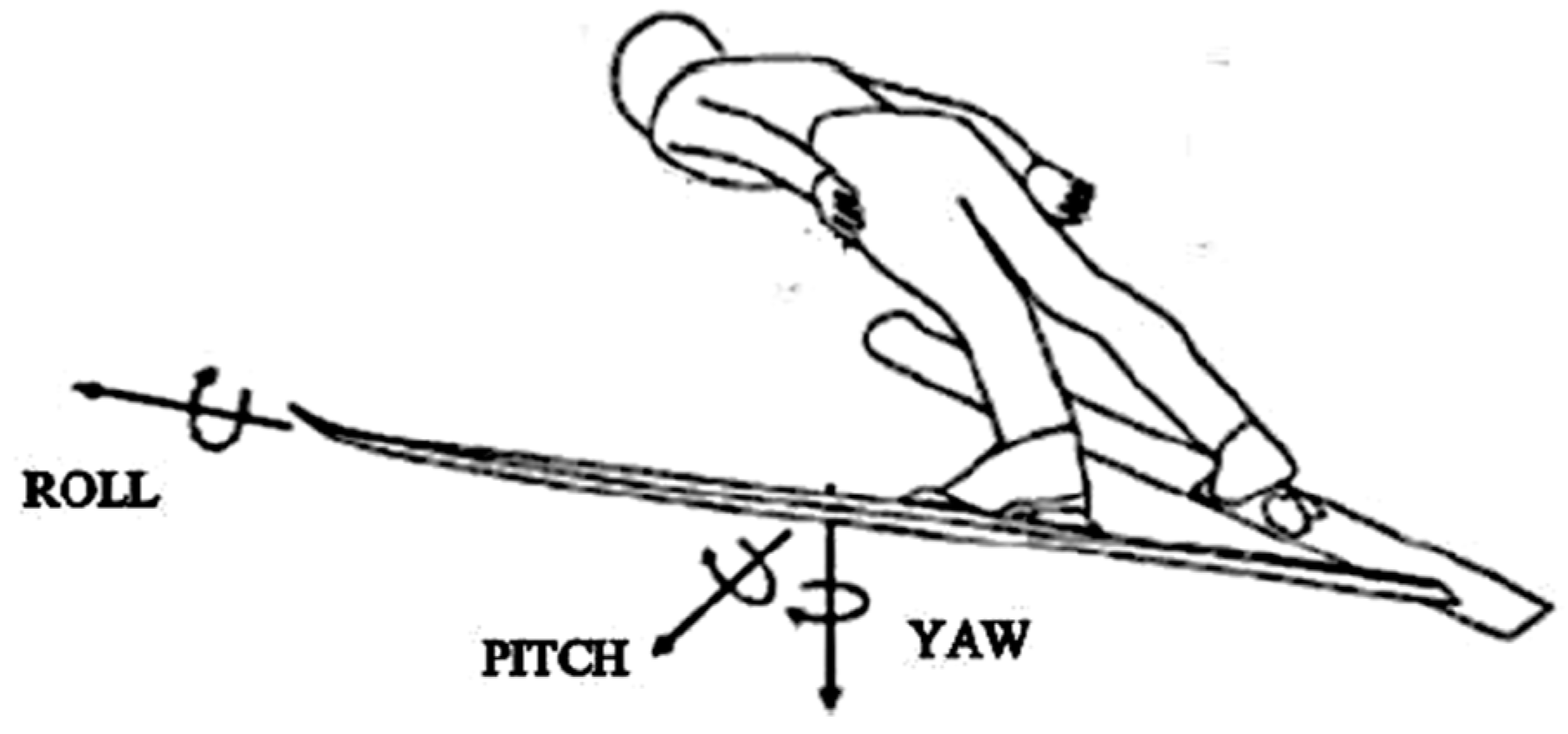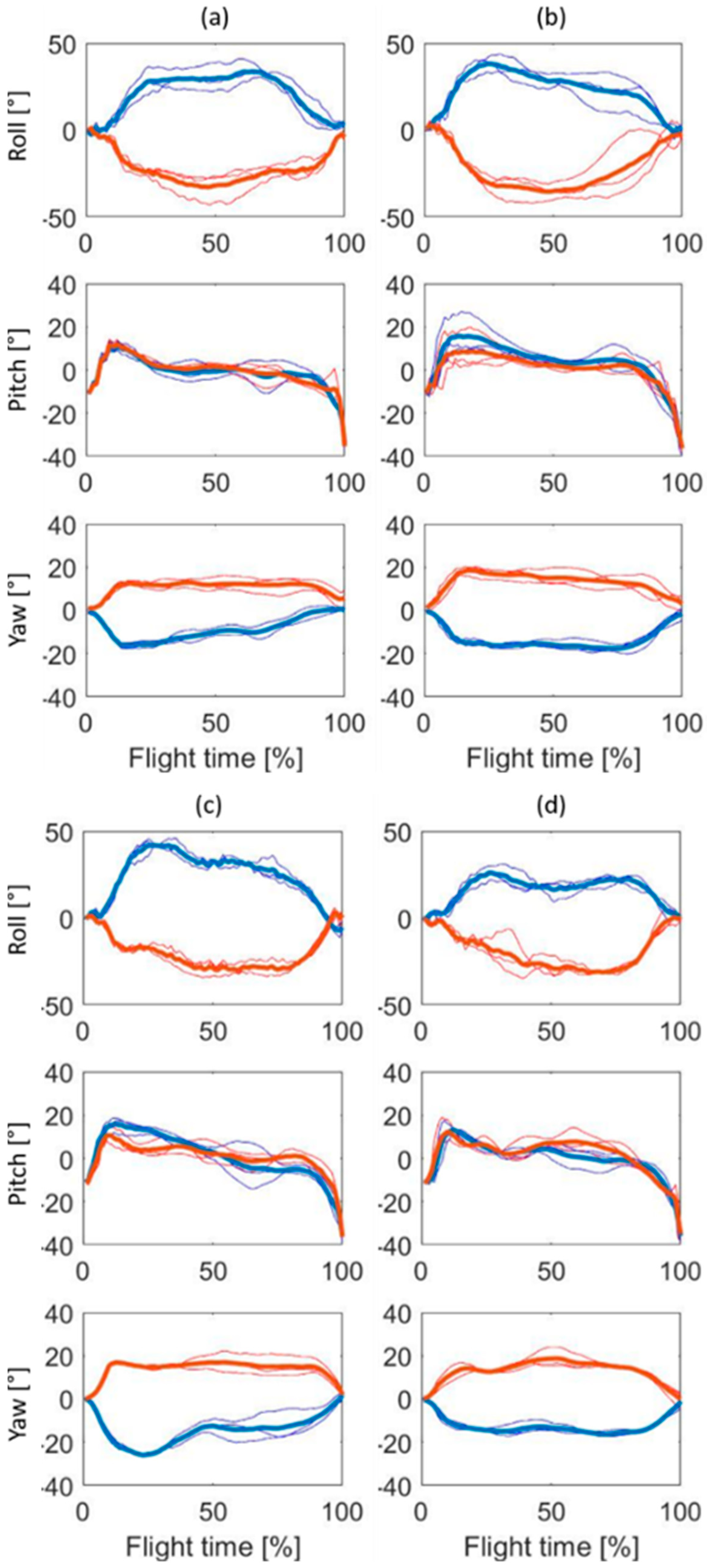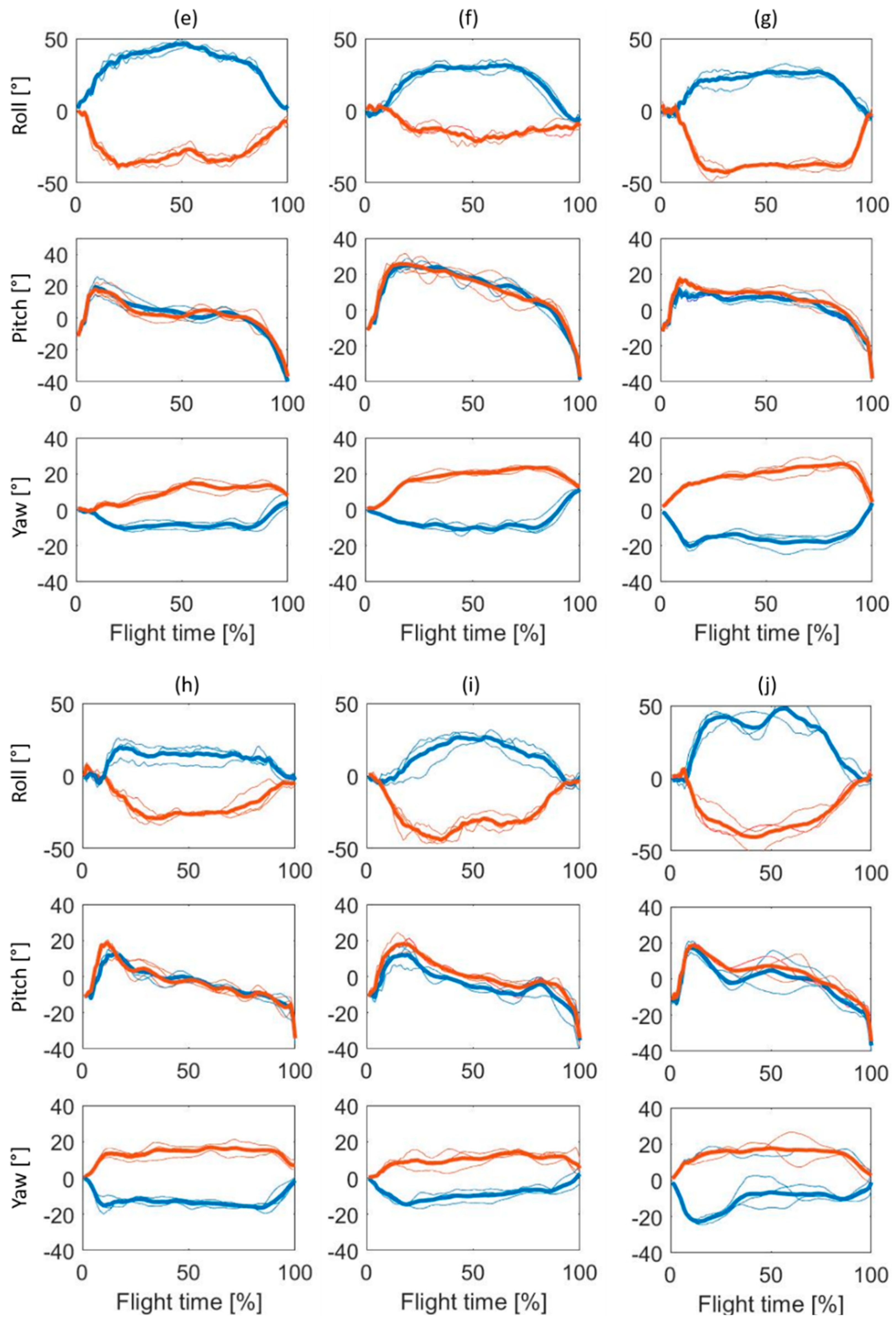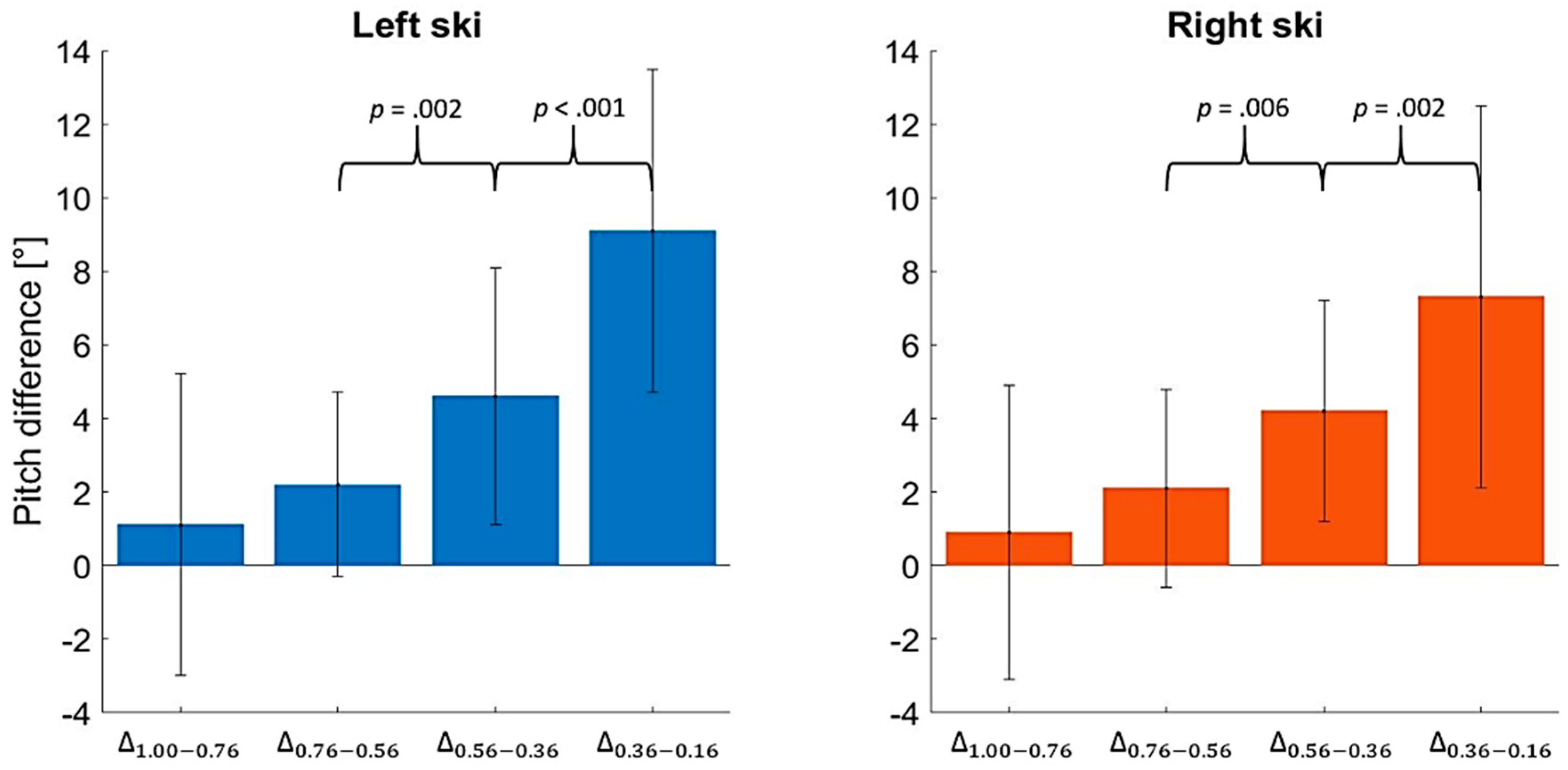Ski Position during the Flight and Landing Preparation Phases in Ski Jumping Detected with Inertial Sensors
Abstract
1. Introduction
- (i)
- Each athlete owns his specific ski pattern during the flight performance, depending on the competition level and expertise [7];
- (ii)
- The pitch (rotation around the frontal axis) during the landing preparation is the ski movement that mainly acts on the impact kinetics, being related to the angle of attack [1];
- (iii)
- The roll (rotation around the sagittal axis) during the impact influences GRF, since it influences the direction of GRF resultant vector;
- (iv)
- Around 0.40 s before the landing impact as in [4], the main ski movements that lead to the start of the landing preparation happen.
2. Materials and Methods
2.1. Set-Up Description
2.2. Data Processing and Variable Definition
2.3. Statistical Analysis
3. Results
3.1. Ski Movement during the Flight Phase
3.2. Ski Movement during the Landing and Its Preparation Phases and Influence with the Kinetics
4. Discussion
4.1. Ski Movement during the Flight Phase
4.2. Ski Movement during the Landing and Its Preparation Phases and Influence with the Kinetics
4.3. Limitations and Methodological Considerations
5. Conclusions
Author Contributions
Funding
Acknowledgments
Conflicts of Interest
References
- Seo, K.; Watanabe, T.; Igarashi, M.; Kimura, S.; Murakami, M. Aerodynamic Study for the Ground Effect of Ski Jumping. Available online: https://ojs.ub.uni-konstanz.de/cpa/article/view/3835 (accessed on 28 April 2019).
- Hochmuth, G. Telemark Landing. FIS Bull. 1999, 137, 29–43. [Google Scholar]
- Watanabe, T.; Kasaya, A.; Kawahara, Y. Kinematic studies on ski jumping. In Proceedings of the International Congress of Winter Sports Medicine, Sapporo, Japan, 3–13 February 1972; pp. 98–105. [Google Scholar]
- Greimel, F.; Virmavirta, M.; Schwameder, H. Kinematic analysis of the landing phase in ski jumping. In International Conference of Science and Skiing; Science and Skiing IV; Müller, E., Lindinger, S., Stöggl, T., Eds.; Meyer and Meyer Sport: Maidenhead, UK, 2009; pp. 721–727. [Google Scholar]
- FIS International Competition Rules (ICR) Ski Jumping. Available online: http://www.fis-ski.com/inside-fis/document-library/ski-jumping/index.html#deeplink=rules (accessed on 10 January 2019).
- Ito, S.; Seo, K.; Asai, T. An experimental study on ski jumping styles; Estivalet, M., Brisson, B., Eds.; The Engineering of Sport 7; Springer: Paris, France, 2008; Volume 2, pp. 9–18. [Google Scholar]
- Marqués-Bruna, P.; Grimshaw, P. Mechanics of flight in ski jumping: Aerodynamic stability in pitch. Sports Technol. 2009, 2, 24–31. [Google Scholar] [CrossRef]
- Kreibich, S.; Müller, S.; Krüger, A. Sensor based measurement of ski orientation angles in ski jumping. In Science and Skiing V; Müller, E., Lindinger, S., Stöggl, T., Eds.; Meyer and Meyer Sport: Maidenhead, UK, 2012; pp. 608–618. [Google Scholar]
- Fasel, B.; Favre, J.; Chardonnens, J.; Gremion, G.; Aminian, K. An inertial sensor-based system for spatio-temporal analysis in classic cross-country skiing diagonal technique. J. Biomech. 2015, 18, 3199–3205. [Google Scholar] [CrossRef] [PubMed]
- Fasel, B.; Praz, C.; Kayser, B.; Aminian, K. Measuring spatio-temporal parameters of uphill ski-mountaineering with ski-fixed inertial sensors. J. Biomech. 2016, 6, 3052–3055. [Google Scholar] [CrossRef] [PubMed]
- Gellaerts, J.; Bogdanov, E.; Dadashi, F.; Mariani, B. In-field validation of an inertial sensor-based system for movement analysis and classification in ski mountaineering. Sensors 2018, 18, 885. [Google Scholar] [CrossRef] [PubMed]
- Kodyian, A.; Bessone, V.; Kocbach, J.; Dadashi, F. Cross country technique and sub-technique classification using a single inertial sensor placed on the ski. In Proceedings of the International Conference of Science and Skiing, Vuokatti, Finland, 11–15 March 2019. [Google Scholar]
- Sakurai, Y.; Fujita, Z.; Ishige, Y. Automated identification and evaluation of subtechniques in classical-style roller skiing. J. Sports Sci. Med. 2014, 13, 651–657. [Google Scholar]
- Sakurai, Y.; Fujita, Z.; Ishige, Y. Automatic identification of subtechniques in skating-style roller skiing using inertial sensors. Sensors 2016, 16, 473. [Google Scholar] [CrossRef] [PubMed]
- Breitschadel, F.; Berre, V.; Andersen, R.; Stiernstroem, E. A comparison between timed and IMU captured Nordic ski glide tests. Proced. Eng. 2012, 34, 397–402. [Google Scholar] [CrossRef]
- Camomilla, V.; Bergamini, E.; Fantozzi, S.; Vannozzi, G. In-field use of wearable magneto-inertial sensors for sports performance evaluation. In Proceedings of the 33rd International Conference on Biomechanics in Sports, Poitiers, France, 29 June–3 July 2015. [Google Scholar]
- Chardonnens, J.; Favre, J.; Aminian, K. An effortless procedure to align the local frame of an inertial measurement unit to the local frame another motion capture system. J. Biomech. 2012, 45, 2297–2300. [Google Scholar] [CrossRef]
- Chardonnens, J.; Favre, J.; Cuendet, F.; Grémion, G.; Aminian, K. A system to measure the kinematics during the entire jump sequence using inertial sensors. J. Biomech. 2013, 46, 56–62. [Google Scholar] [CrossRef]
- Brock, H.; Ohgi, Y. Development of an inertial motion capture system for kinematic analysis of ski jumping. Proceedings of the Institution of Mechanical Engineers. J. Sports Eng. Technol. 2016, 4, 275–286. [Google Scholar] [CrossRef]
- Logar, G.; Munih, M. Estimation of joint forces and moments for the in-run and take-off in ski jumping based on measurements with wearable inertial sensors. Sensors 2015, 15, 11258–11276. [Google Scholar] [CrossRef]
- Bessone, V.; Petrat, J.; Schwirtz, A. Ground reaction forces and kinematics of ski jump landing using wearable sensors. Sensors 2019, 19, 2011. [Google Scholar] [CrossRef] [PubMed]
- Groh, B.J.; Warschun, F.; Deininger, M.; Kautz, T.; Martindale, C.; Eskofier, B. Automated Ski Velocity and Jump Length Determination in Ski Jumping Based on Unobtrusive and Wearable Sensors. In Proceedings of the ACM on Interactive, Mobile, Wearable and Ubiquitous Technologies; ACM: New York, NY, USA, 2017; Volume 1, pp. 1–17. [Google Scholar] [CrossRef]
- Groh, B.J.; Fritz, J.; Deininger, M.; Schwameder, H.; Eskofier, B.M. Unobstrusive and wearable landing momentum estimation in ski jumping with inertial-magnetic sensors. In Proceedings of the 15th International Conference on Wearable and Implantable Body Sensor Networks (BSN), Las Vegas, NV, USA, 4–7 March 2018. [Google Scholar]
- Bessone, V.; Petrat, J.; Seiberl, W.; Schwirtz, A. Analysis of landing in ski jumping by means of inertial sensors and force insoles. Proceedings 2018, 2, 311. [Google Scholar] [CrossRef]
- Burns, T.B.; Zendler, J.D.; Zernicke, R.F. Validation of a wireless shoe insole for ground reaction force measurement. J. Sports Sci. 2018, 14, 1–10. [Google Scholar] [CrossRef]
- Peeble, A.T.; Maguire, L.A.; Renner, R.K.; Queen, R.M. Validity and repeatability of single-sensor loadsol insoles during landing. Sensors 2018, 18, 4082. [Google Scholar] [CrossRef] [PubMed]
- Seiberl, W.; Jensen, E.; Merker, J.; Leitel, M.; Schwirtz, A. Accuracy and precision of loadsol® insole force-sensors for the quantification of ground reaction force-based biomechanical running parameters. Eur. J. Sport Sci. 2018, 18, 1100–1109. [Google Scholar] [CrossRef] [PubMed]
- Renner, R.K.; Williams, B.D.S.; Queen, R.M. The reliability and validity of the loadsol® under various walking and running conditions. Sensors 2019, 19, 265. [Google Scholar] [CrossRef]
- Loadsol–Mobile Force Sensor. Available online: http://novel.de/novelcontent/loadsol (accessed on 19 February 2019).
- Fang, X.; Göttlicher, C.; Holzapfel, F. Attitude estimation of skis in ski jumping using low-cost inertial measurement units. Proceedings 2018, 2, 317. [Google Scholar] [CrossRef]
- Ski Jumping Hill Archive. Available online: http://www.skisprungschanzen.com/EN/Ski+Jumps/ (accessed on 23 September 2017).
- Jin, H.; Shimizu, S.; Watanuki, T.; Kubota, H.; Kobayashi, K. Desirable gliding styles and techniques in ski jumping. J. Appl. Biomech. 1995, 11, 460–474. [Google Scholar] [CrossRef]
- Schwameder, H. Biomechanics research in ski jumping–1991-2006. Sports Biomech. 2008, 7, 114–136. [Google Scholar] [CrossRef] [PubMed]
- Oggiano, L.; Setran, L. Effects of Body Weight on Ski Jumping Performances under the New FIS Rules. In Proceedings of the 7th International Conference of the Sport Engineering Association, Biarritz, France, 2–6 June 2008. [Google Scholar] [CrossRef]
- Virmavirta, M.; Kivekäs, J. Is it still important to be light in ski jumping? Sports Biomech. 2019. [Google Scholar] [CrossRef] [PubMed]
- Marqués-Bruna, P.; Grimshaw, P. Mechanics of flight in ski jumping: Aerodynamic stability in roll and yaw. Sports Technol. 2009, 2, 111–120. [Google Scholar] [CrossRef]
- Virmavirta, M.; Kivekäs, J. Aerodynamics of an isolated ski jumping ski. Sports Eng. 2019, 22, 8. [Google Scholar] [CrossRef]







| Ramsau-am-Dachstein (n = 4) | Oberhof (n = 6) | |
|---|---|---|
| tflight [s] | 3.33 ± 0.20 | 3.33 ± 0.27 |
| tlanding [s] | 0.19 ± 0.03 | 0.16 ± 0.03 |
| Normal GRFmax [BW] | 3.1 ± 1.0 | 2.8 ± 0.8 |
| I [BWs] | 154.5 ± 33.1 | 146.4 ± 30.5 |
| tflight | tlanding | Normal GRFmax | I | ||||||
|---|---|---|---|---|---|---|---|---|---|
| L | R | L | R | L | R | ||||
| t0.16 | Roll | L | r = 0.639** | ||||||
| R | r = 0.596** | ||||||||
| Pitch | L | r = 0.492* | |||||||
| R | r = 0.510* | r = 0.520* | |||||||
| Yaw | L | r = 0.525* | r = 0.519* | ||||||
| R | |||||||||
| t0.36 | Roll | L | |||||||
| R | r= 0.618** | ||||||||
| Pitch | L | r = −0.595* | |||||||
| R | r = 0.526* | r = 0.557* | r = 0.602* | ||||||
| Yaw | L | ||||||||
| R | r = 0.504* | r = 0.509* | r = 0.629** | ||||||
| t0.56 | Roll | L | r = 0.664** | ||||||
| R | r = 0.517* | ||||||||
| Pitch | L | r= 0.714* | r = 0.608** | r = 0.685** | r = 0.500* | ||||
| R | r= 0.499* | r = 0.615** | |||||||
| Yaw | L | r = 0.697** | |||||||
| R | r = 0.482* | ||||||||
| t0.76 | Raw | L | r = 0.714** | ||||||
| R | |||||||||
| Pitch | L | r= 0.755* | r = 0.623** | r = 0.736** | |||||
| R | r = 0.634** | ||||||||
| Yaw | L | r = 0.690* | |||||||
| R | r = 0.478* | ||||||||
| t1.00 | Roll | L | r = 0.482* | r = 0.494* | r = 0.715** | ||||
| R | |||||||||
| Pitch | L | r= 0.708* | r= 0.623** | r = 0.736** | |||||
| R | r = 0.522* | r = 0.477 * | r = 0.575* | ||||||
| Yaw | L | r = 0.702** | |||||||
| R | |||||||||
| Tflight | tlanding | Normal GRFmax | I | ||||||
|---|---|---|---|---|---|---|---|---|---|
| L | R | L | R | L | R | ||||
| t0.36 | Roll | L | |||||||
| R | r = 0.699* | r = 0.712* | |||||||
| Pitch | L | r = 0.656* | |||||||
| R | r = 0.577* | ||||||||
| Yaw | L | ||||||||
| R | |||||||||
| t0.56 | Roll | L | |||||||
| R | |||||||||
| Pitch | L | r = 0.887*** | |||||||
| R | r = 0.611* | r = 0.588* | r = 0.634* | r = 0.662* | |||||
| Yaw | L | ||||||||
| R | |||||||||
| t0.76 | Raw | L | r = −0.678* | ||||||
| R | |||||||||
| Pitch | L | r = 0.844* | |||||||
| R | r = 0.660* | r = 0.628* | r = 0.611* | r = 0.631* | r = 0.715** | ||||
| Yaw | L | r = −0.592* | |||||||
| R | |||||||||
| t1.00 | Roll | L | r = −0.736** | ||||||
| R | |||||||||
| Pitch | L | r = 0.599* | r = 0.664* | r = 0.631* | |||||
| R | |||||||||
| Yaw | L | ||||||||
| R | r = 0.632* | ||||||||
© 2019 by the authors. Licensee MDPI, Basel, Switzerland. This article is an open access article distributed under the terms and conditions of the Creative Commons Attribution (CC BY) license (http://creativecommons.org/licenses/by/4.0/).
Share and Cite
Bessone, V.; Petrat, J.; Schwirtz, A. Ski Position during the Flight and Landing Preparation Phases in Ski Jumping Detected with Inertial Sensors. Sensors 2019, 19, 2575. https://doi.org/10.3390/s19112575
Bessone V, Petrat J, Schwirtz A. Ski Position during the Flight and Landing Preparation Phases in Ski Jumping Detected with Inertial Sensors. Sensors. 2019; 19(11):2575. https://doi.org/10.3390/s19112575
Chicago/Turabian StyleBessone, Veronica, Johannes Petrat, and Ansgar Schwirtz. 2019. "Ski Position during the Flight and Landing Preparation Phases in Ski Jumping Detected with Inertial Sensors" Sensors 19, no. 11: 2575. https://doi.org/10.3390/s19112575
APA StyleBessone, V., Petrat, J., & Schwirtz, A. (2019). Ski Position during the Flight and Landing Preparation Phases in Ski Jumping Detected with Inertial Sensors. Sensors, 19(11), 2575. https://doi.org/10.3390/s19112575





